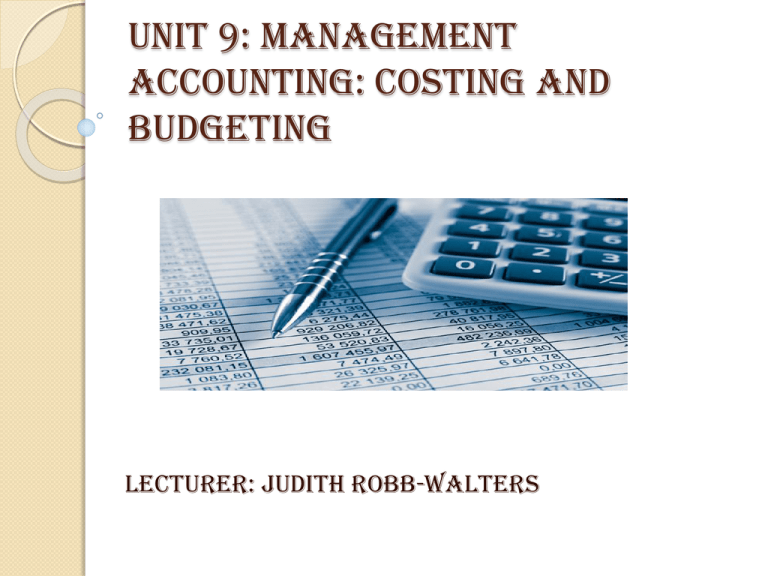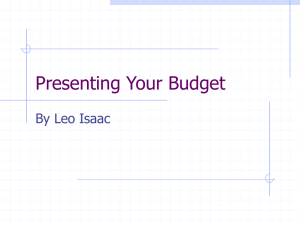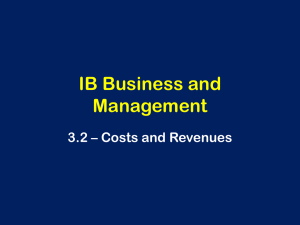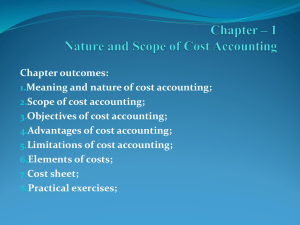UNIT 9: MANAGEMENT ACCOUNTING: COSTING AND BUDGETING
advertisement

UNIT 9: MANAGEMENT ACCOUNTING: COSTING AND BUDGETING LECTURER: JUDITH ROBB-WALTERS UNIT 9: MANAGEMENT ACCOUNTING: COSTING AND BUDGETING LEARNING OBJECTIVE1: BE ABLE TO ANALYSE COST INFORMATION WITHIN A BUSINESS THE BASIC SYLLABUS 1. Be able to analyse cost information within a business. 2.Be able to propose methods to reduce costs and enhance value within a business. 3. Be able to prepare forecasts and budgets for a business. 4. Be able to monitor performance against budgets within a business. LEARINGING OUTCOMES Be able to analyse cost information within a business At the end of the class the students should be able to: 1.1 Classify different types of cost OVERVIEW Cost behaviour means how a cost will react or respond to changes in the level of business activity. As the activity level rises and falls, a particular cost may rise and fall as well – or it may remain constant. For planning purposes, a manager must be able to anticipate which of these will happen; and if a cost can be expected to change, the manager must know by how much it will change. To help make such distinctions, costs are often categorized as variable or fixed. MATERIALS The materials that go into the final product are called raw materials. This term is somewhat misleading, since it seems to imply unprocessed natural resources like wood pulp or iron ore. Actually, raw materials refer to any materials that are used in the final product; and the finished product of one company can become the raw materials of another company. Direct materials are those materials that become an integral part of the finished product and that can be physically and conveniently traced to it. MATERIALS Sometimes it isn’t worth the effort to trace the costs of relatively insignificant materials to the end products. Such minor items would include the solder used to make electrical connections in a TV. Materials such as solder and glue are called indirect materials and are included as part of manufacturing overhead, which is discussed later in this section. LABOUR Labour cost is the second important element of cost of production. Wages, salaries and other forms of remunerations represent a major portion of the total cost of a product or services. The growth and profitability of the concern depends upon proper utilization of human resources or labour forces which in turn needs proper accounting and control of cost. LABOUR Thus, control of labour cost is a very significant issue from the viewpoint of management. Types of labour Cost The labour cost can be classified into two types : (1) Direct labour Cost. (2) Indirect labour Cost. overheads Overheads – Overheads comprise of indirect materials, indirect employee costs and indirect expenses which are not directly identifiable or allocable to a cost object in an economically feasible way. Overheads are to be classified on the basis of functions to which the overheads are related - Production overheads - Administrative overheads - Selling overheads - Distribution overheads Overheads may also be classified on the basis of behaviour such as variable overheads, semi-variable overheads and fixed overheads. overheads Variable overheads comprise of expenses which vary in proportion to the change of volume of production. For example, cost of utilities etc. Fixed overheads comprise of expenses whose value do not change with the change in volume of production such as salaries, rent etc. Semi-variable overheads are partly affected by change in the production volume. They are further segregated into variable overheads and fixed overheads overheads Any items of overheads arising out of abnormal situation in business activity should not be treated as overheads. They are charged to Costing Profit and Loss Account. Items not related to business activities such as donation, loss / profit on sale of assets etc are also not to be treated as overheads. Borrowing cost and other financial charges including foreign exchange fluctuations will not form the part of overheads. DIRECT costs Direct costs can be defined as costs which can be accurately traced to a cost object with little effort. Cost object may be a product, a department, a project, etc. Direct costs typically benefit a single cost object therefore the classification of any cost either as direct or indirect is done by taking the cost object into perspective. A particular cost may be direct cost for one cost object but indirect cost for another cost object. DIRECT costs Most direct costs are variable but this may not always be the case. For example, the salary of a supervisor for a month who has only supervised the construction of a single building is a direct fixed cost incurred on the building. Examples: Cost of gravel, sand, cement and wages incurred on production of concrete. INDIRECT costs Costs which cannot be accurately attributed to specific cost objects are called indirect costs. These typically benefit multiple cost objects and it is impracticable to accurately trace them to individual products, activities or departments etc. Examples: Cost of depreciation, insurance, power, salaries of supervisors incurred in a concrete plant. FIXED COSTS A fixed cost is a cost which is incurred for an accounting period, and which, within certain activity levels remains constant. FIXED COSTS Fixed costs can be shown graphically as follows: FIXED COSTS The total cost remains constant over a given level of activity but that the cost per unit falls as the level of activity increases. Examples of fixed costs include rent, business rates and executive salaries. Numerical illustration of a fixed cost graph If factory rent is $5,000 per month, this cost will be incurred whether 2 hamburgers are made, or 200 hamburgers are made - graph 1 demonstrates this. If 2 hamburgers are made the fixed cost per unit is $5,000/2 i.e. $2,500 per hamburger. If 200 hamburgers are made the fixed cost per unit is $5,000/200, i.e. $25 per hamburger. Therefore, the fixed cost per unit falls at a reducing rate but never reaches zero - graph 2 demonstrates this. Variable costs Variable costs are costs that tend to vary in total with the level of activity. As activity levels increase then total variable costs will also increase. Variable costs Variable costs can be shown graphically as follows: Variable costs As total costs increase with activity levels, the cost per unit of variable costs remains constant. Examples of variable costs include direct costs such as raw materials and direct labour. Numerical example of variable costs A factory is producing shirts. It takes 2 yards to make one shirt and it costs $2 per yard. If the factory makes 50 shirts if costs $400, if the factory makes 100 shirts it costs $800. The cost incurred increases inline with the volume being produced - graph 1 demonstrates this. The material for each shirt costs 4 x $2 = $8 and it does not change if more or less shirts are made. The variable cost per unit remains constant - graph 2 demonstrates this. semi-variable costs Semi-variable costs contain both fixed and variable cost elements and are therefore partly affected by fluctuations in the level of activity. semi-variable costs Semi-variable costs can be shown graphically as follows: semi-variable costs Examples of semi-variable costs: electricity bills (fixed standing charge plus variable cost per unit of electricity consumed) telephone bills (fixed line rental plus variable cost per call) REVIEW QUESTIONS Rule Manufacturing Company – selected data Five sales reps are paid 10% commissions plus $5,000 monthly salary each Utilities cost $10,000 per month plus $10 per unit manufactured Materials cost is $75 per unit Equipment cost $500,000 and has an expected life of 3,000,000 units with no salvage value Rent is $100,000 per month Other salaries are $200,000 per month From these, we can identify the fixed and variable costs: REVIEW QUESTIONS From the information presented: 1. Identify the fixed and variable costs 2. Calculate the total fixed and variable costs. BIBLIOGRAPHY . 'Cost Terms And Concepts'. 1st ed. McGraw Hill Education, 2015. Print Lake Erie. 'Managerial Accounting And Cost Concepts'. 1st ed. 2015. 33. Print. 'Labour Cost Control'. A Textbook Of Financial Cost And Management Accounting. 1st ed. 2015. 368. Print. http://www.costauditorindia.co.in/pdf/03CAS-3-Overheads.pdf access date: August 31,2015 Accountingexplained.com,. 'Direct Costs And Indirect Costs Defined | Examples'. N.p., 2015. Web. 31 Aug. 2015. Kfknowledgebank.kaplan.co.uk,. N.p., 2015. Web. 31 Aug. 2015. College-cram.com,. 'Fixed Costs And Variable Costs | Finance: Weblog | College-Cram.Com'. N.p., 2015. Web. 2 Sept. 2015.






